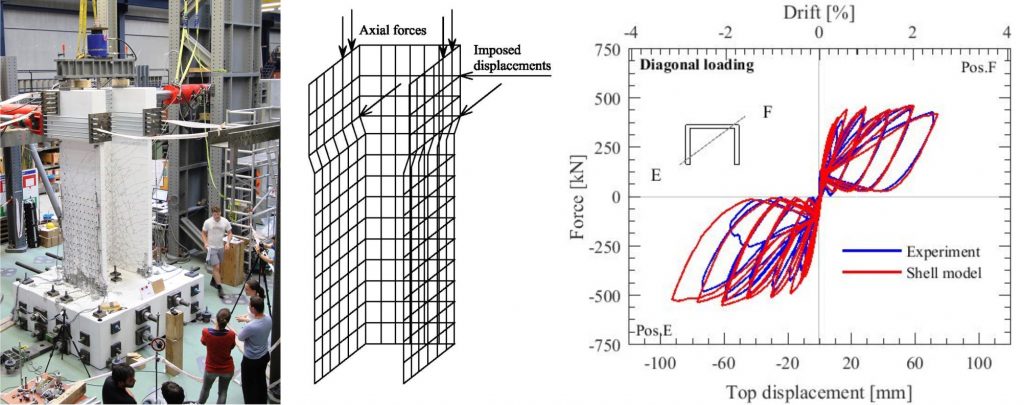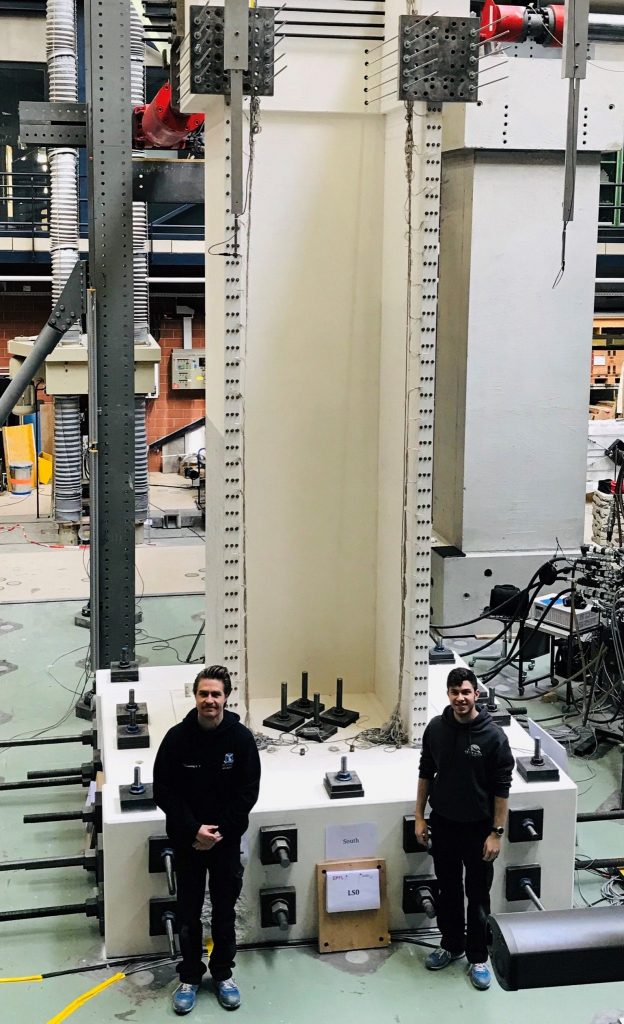Although RC core walls are very popular in practice, their seismic behaviour has not been studied in depth but most of the research on structural walls focused on the seismic behaviour of the simpler rectangular walls. As a consequence, current codes are based on the findings from rectangular walls and provide insufficient guidelines on the design and modelling of core walls, leaving critical decisions – like for example the shear force distribution between the different webs and flanges of the core wall – to the design engineer.
The research project focuses on core walls with U-shaped sections, which are the simplest of all core wall sections. A particular emphasis lies on the behaviour of such walls when subjected to bi-directional loading. Tests have shown that the critical loading direction is in fact the diagonal loading direction when the flange end is in compression. It was found that at this position, (i) differences in vertical strains on the inner and outer side of the flange ends promotes out-of-plane buckling of the flange ends, (ii) plane section analysis does not yield reliable moment capacity estimates, (iii) the compression depth is largest exposing unconfined concrete to large compressive strains. Experimental and numerical investigations are used to improve design and assessment guidelines for RC core walls.

- Article:
- Behaviour of U-shaped RC walls under quasi-static cyclic diagonal loading [journal link]
- Dataset: [dataset link]
- Funding: Swiss National Science Foundation
Slender RC U-shaped core walls
There has recently been a proliferation of mid- to high-rise reinforced concrete (RC) shear wall buildings in several Latin American countries. Due to some loopholes in the current material standards in some Latin American countries (e.g. Colombia), it is anticipated that many of the reinforced concrete (RC) walls embedded in mid- to high-rise buildings are slender (80 – 100 mm), unconfined, and detailed with a single-layer of vertical reinforcement. RC walls (or cores) are often non-rectangular due to architectural and structural requirements, where the U-shaped wall is amongst the simplest and most popular non-rectangular walls used in construction internationally. Due to observations from recent earthquake events, there has been a great deal of experimental and numerical investigative research focusing on the out-of-plane instability of RC walls due to in-plane loading. However, all of these recently tested specimens were either planar (i.e., rectangular) walls or idealized boundary elements. Thus, there is a need for experimental research focusing on the out-of-plane instability of non-planar walls with large, flanged sections, such as U-shaped walls.
This research investigates the seismic performance of slender RC U-shaped walls with a single-layer of reinforcement by testing two large-scale specimens. Both wall specimens, designed similar to construction practice in Colombia, were tested using quasi-static cyclic loading to observe if out-of-plane instability would develop when deformations were limited to prevent the flange boundary ends crushing. The initial failure of both wall specimens corresponded with local out-of-plane buckling in the boundary ends of the flanges occurring on load reversal. The buckling lengths were approximately 700-800 mm, which corresponded to 44-50 bar diameters. Both wall specimens reached ultimate drifts larger than 2.5-3.0% before global failure occurring in the web-flange intersection due to crushing. A small twist was subjected to one of the walls when centred and loaded diagonally, which showed that the decay in torsional stiffness is proportional to the decay in translational stiffness.

- Article:
- RC U-shaped walls subjected to in-plane, diagonal, and torsional loading: New experimental findings [journal link]
- Decay of torsional stiffness in RC U-shaped walls [journal link]
- Seismic performance of slender RC U-shaped walls with a single-layer of reinforcement [journal link]
- Dataset: [dataset link]
- Funding:
- Swiss Government Excellence Postdoctoral Scholarship
- Fulbright US Student Program
- Swiss Bilateral Research Programs for the Latin American Region (One-Year Research Merger Scheme)